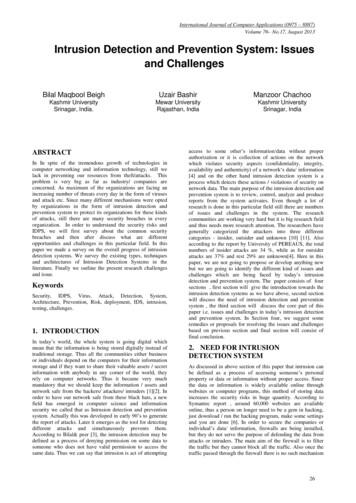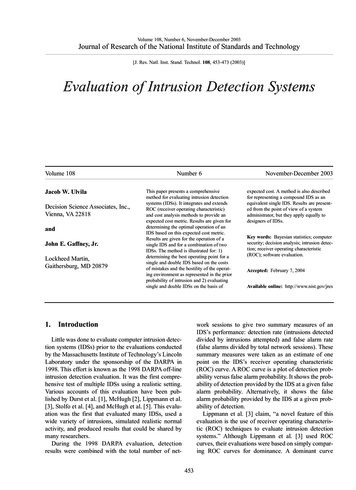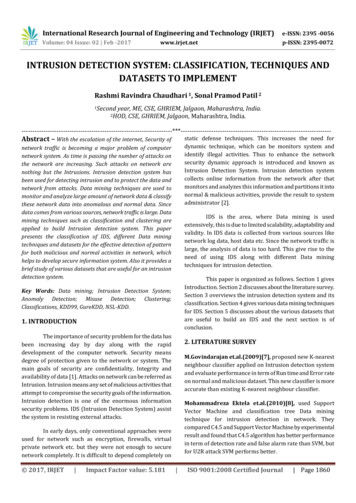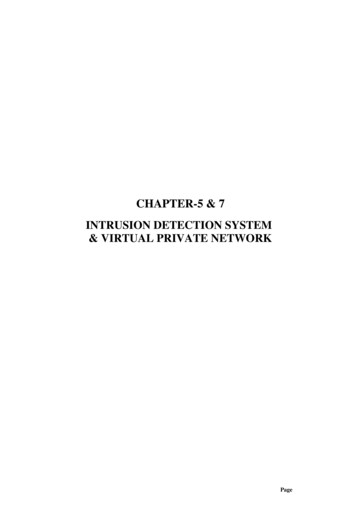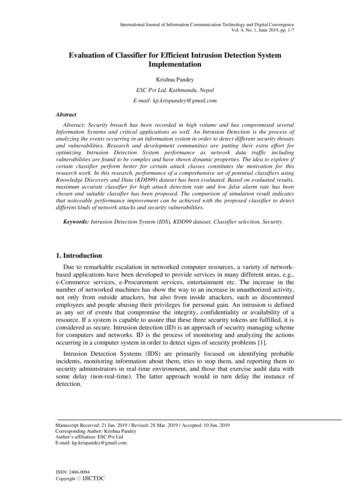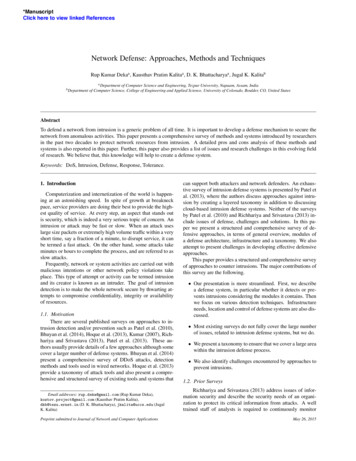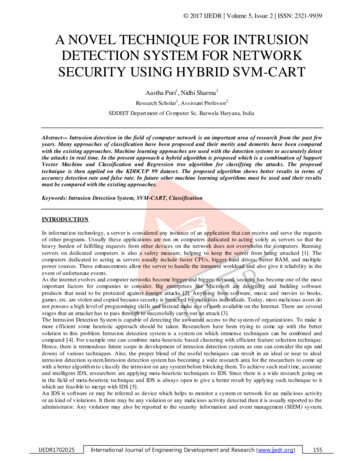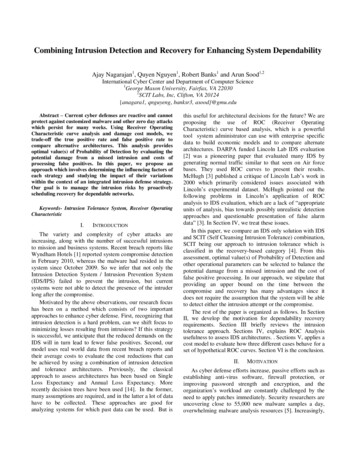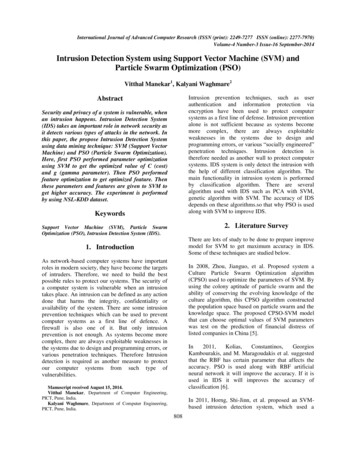
Transcription
International Journal of Advanced Computer Research (ISSN (print): 2249-7277 ISSN (online): 2277-7970)Volume-4 Number-3 Issue-16 September-2014Intrusion Detection System using Support Vector Machine (SVM) andParticle Swarm Optimization (PSO)Vitthal Manekar1, Kalyani Waghmare2Intrusion prevention techniques, such as userauthentication and information protection viaencryption have been used to protect computersystems as a first line of defense. Intrusion preventionalone is not sufficient because as systems becomemore complex, there are always exploitableweaknesses in the systems due to design andprogramming errors, or various “socially engineered”penetration techniques. Intrusion detection istherefore needed as another wall to protect computersystems. IDS system is only detect the intrusion withthe help of different classification algorithm. Themain functionality in intrusion system is performedby classification algorithm. There are severalalgorithm used with IDS such as PCA with SVM,genetic algorithm with SVM. The accuracy of IDSdepends on these algorithms.so that why PSO is usedalong with SVM to improve IDS.AbstractSecurity and privacy of a system is vulnerable, whenan intrusion happens. Intrusion Detection System(IDS) takes an important role in network security asit detects various types of attacks in the network. Inthis paper, the propose Intrusion Detection Systemusing data mining technique: SVM (Support VectorMachine) and PSO (Particle Swarm Optimization).Here, first PSO performed parameter optimizationusing SVM to get the optimized value of C (cost)and g (gamma parameter). Then PSO performedfeature optimization to get optimized feature. Thenthese parameters and features are given to SVM toget higher accuracy. The experiment is performedby using NSL-KDD dataset.Keywords2. Literature SurveySupport Vector Machine (SVM), Particle SwarmOptimization (PSO), Intrusion Detection System (IDS).There are lots of study to be done to prepare improvemodel for SVM to get maximum accuracy in IDS.Some of these techniques are studied below.1. IntroductionAs network-based computer systems have importantroles in modern society, they have become the targetsof intruders. Therefore, we need to build the bestpossible rules to protect our systems. The security ofa computer system is vulnerable when an intrusiontakes place. An intrusion can be defined as any actiondone that harms the integrity, confidentiality oravailability of the system. There are some intrusionprevention techniques which can be used to preventcomputer systems as a first line of defence. Afirewall is also one of it. But only intrusionprevention is not enough. As systems become morecomplex, there are always exploitable weaknesses inthe systems due to design and programming errors, orvarious penetration techniques. Therefore Intrusiondetection is required as another measure to protectour computer systems from such type ofvulnerabilities.In 2008, Zhou, Jianguo, et al. Proposed system aCulture Particle Swarm Optimization algorithm(CPSO) used to optimize the parameters of SVM. Byusing the colony aptitude of particle swarm and theability of conserving the evolving knowledge of theculture algorithm, this CPSO algorithm constructedthe population space based on particle swarm and theknowledge space. The proposed CPSO-SVM modelthat can choose optimal values of SVM parameterswas test on the prediction of financial distress oflisted companies in China , and M. Maragoudakis et al. suggestedthat the RBF has certain parameter that affects theaccuracy. PSO is used along with RBF artificialneural network it will improve the accuracy. If it isused in IDS it will improves the accuracy ofclassification [6].Manuscript received August 15, 2014.Vitthal Manekar, Department of Computer Engineering,PICT, Pune, India.Kalyani Waghmare, Department of Computer Engineering,PICT, Pune, India.In 2011, Horng, Shi-Jinn, et al. proposed an SVMbased intrusion detection system, which used a808
International Journal of Advanced Computer Research (ISSN (print): 2249-7277 ISSN (online): 2277-7970)Volume-4 Number-3 Issue-16 September-2014hierarchical clustering algorithm, leave one out, andthe SVM technique. The hierarchical clusteringalgorithm provided the SVM with fewer, abstracted,and higher-qualified training instances that arederived from the KDD Cup 1999 training set. It wasable to greatly minimize the training time, andimprove the performance of SVM. The simplefeature selection procedure (leave one out) wasapplied to eliminate unimportant features from thetraining set so the obtained SVM model couldclassify the network traffic data more accurately [1].single connection vector) in the database has 41attributes.B. Conversion of datasets to LibSVMformat:Pre-processed datasets are converted to LibSVMformat. In this process, first categorical features fromboth training and testing datasets are converted to anumeric value and then we have to determine targetclasses for classification phase. Here, conversion andscaling function determined two target classes: class„zero‟ for normal instance and class „one‟ for attackor intrusion [7]. Then it saved target class and featurevalues of each instance in LibSVM format.In 2012, Gaspar, Paulo, Jaime Carbonell, and JoséLuís Oliveira et al. gave the review on strategies thatare used to improve the classification performance interm of accuracy of SVMs and perform someexperimentation to study the influence of features andhyper-parameters in the optimization process, usingkernels function. Huang et al provide a study on thejoint optimization of C and g parameters (using theRBF kernel), and feature selection using Grid searchand genetic algorithms [2].LibSVM format is:[Label] [Index 1]:[value 1] [index 2]:[value 2] Where,„Label‟ is target „classes‟ of classification.Usually put integers here. [0, 1] target class„Index‟ is the ordered index. Usually continuousinteger.„Value‟ is the input data for training. Usually lots ofreal (floating point) numbers. Input dataset to theproblem we are trying to solve involves lots of'features' or 'attributes', so the input will be a set (orvector/array).After this step, we have to perform linear scaling ofLibSVM format datasets and store these scaleddatasets for further use. Linear scaling of datasets isdone to improve the performance of SVMclassification.In 2014, Ahmad, Iftikhar, et al. proposed a geneticalgorithm to search the genetic principal componentsthat offers a subset of features with optimalsensitivity and the highest discriminatory power. Thesupport vector machine (SVM) is used forclassification. The results show that proposed methodenhances SVM performance in intrusion detection[3].3. Optimization of SVM using PSOC. Optimization using SVM and PSO:The NSL-KDD dataset in LibSVM format is scaledin [0, 1]. The scaling is the method used to reduce theimpact of bigger value on small value. It improvesthe performance of SVM. Here we are usingLibSVM. Jar for implementation SVM algorithm.The SVM is statistical machine learning algorithmtakes the data input in the form of numeric value andprepare the model or build the model forclassification. There are four type of kernel functionusing SVM for classification. Kernel function is usedto map the dataset into higher dimension. These arelinear, RBF, Polynomial. There are severalparameters used in SVM. In RBF Kernel type ofSVM, there are two parameter C (Cost) and g(gamma). The accuracy of the SVM for RBF typedepends on these two parameters. Optimized value ofthis parameter and features increases the accuracy ofSVM. PSO uses to optimized features andparameters. PSO is dynamic clustering algorithmThere are four steps used in this system. These are asbelow:A. Data Pre-Processing:The training dataset of NSL-KDD consist ofapproximately 4,900,000 single connection vectors[13]. Each connection contains 42 features includingattacks or normal. From these labeled connectionrecords, we need to map the labels to numeric valuesso as to make it suitable to be the input of ourmachine learning algorithm: SVM. Also assign targetclass to the connections according to class labelfeature, which is the last feature in the connectionrecord. By considering this, we have assigned a targetclass „zero‟ for „normal connection‟ and a „one‟ forany deviation from that (i.e. if that is an attack).In this step, some useless data will be filtered andmodified. For example, some text items need to beconverted into numeric values. Every process (i.e.809
International Journal of Advanced Computer Research (ISSN (print): 2249-7277 ISSN (online): 2277-7970)Volume-4 Number-3 Issue-16 September-2014based social interaction [8]. It has fast convergenceability [11]. It works better in integration of SVM [9].The Formula for RBF Kernel Optimization functionExp (-g * Xi -Xj 2)Eqn (1) [12]Finding vectors from training data is formulated asMinimize w 2 CEqn (2)D. Classification Using SVM :The SVM uses a portion of the data to train thesystem, finding several support vectors that representthe training data. These support vectors will form aSVM model. According to this model, the SVM willwork with PSO for C and g (mention in Eqn(1) andEqn(2)) optimization and feature subset selection.And it improves the SVM model. After that SVM isused to classify a given unknown dataset. A basicinput data format and output data domains are listedas followsw, b,4. Experiment ResultIn this Experiment, PSO optimizes the parameters ofSVM (RBF) using SVM and also reduces the featuresof the training set. It reduces he noisy feature fromthe training set. Training set contains 25149 recordsand testing set contains 11850 records. Thealgorithms used in experiment are given below.(Xi, Yi) (Xn, Yn)WhereDuring this Experiment, comparison of Differentkernel unction of SVM with feature selection withaccuracy. The measure of accuracy is givenconfusion matrix [10]. The kernel function used hereare Linear, Gaussian, RBF, Polynomial. The resultsshow that RBF Kernel function with optimizedfeatures gives highest accuracy.X Rm and Y {0, 1}Where (Xi, Yi) . (Xn, Yn) is training datarecords, n is the numbers of samples m is the inputsvector, and y belongs to category of class „0‟ or class‟1‟ respectively. On the problem of linear, a hyperplane can be divided into the two categories as shownin Figure. The hyper plan formula is:(w . x) b 0The category formula is:(w. x) b 0 if Yi 1Table 1: Comparison of accuracy and time ofDifferent kernel function of SVMAlgorithmSVM(RBFwithparameter and featureselectionSVM (RBF withoutFeature Selection)SVM(LinearWithfeature selection)SVM(Gaussianwithfeature selection)(w. x) b 0 if Yi 0AccuracyTime(in 1.986Figure 1: Hyper-Plane of SVMA classification task usually involves with trainingand testing data which consist of some data instances.Each instance in the training set contains one “targetvalue" (class labels: Normal or Attack) and several“attributes" (features).The goal of SVM is to producea model which predicts target value of data instancein the testing set which is given only attributes. Toattain this goal there are four different kernelfunctions.in this experiment RBF kernel function isusedFigure 2: Comparison of Accuracy SVM withDifferent Kernel Function810
International Journal of Advanced Computer Research (ISSN (print): 2249-7277 ISSN (online): 2277-7970)Volume-4 Number-3 Issue-16 September-2014Initialize velocity in range [Cl, Cp] and [gl, gp ]swarm[ i ] {pos, PFitness, velocity, pos, PFitness }if ( swarm[i].fitness bestGlobalfit) ThenbestGlobalfit swarm[i].fitness;bestGlobalpos Swarm[i].pos;End ifEnd ForStep 3: choose particle with best fitness valueWhile ( i max iteration)Do for j from 1 to 10Particle currP swarm[i];Newvelocity w * velocity[j] (c1 * r1 *(currP.bestpos - currP.pos])) (c2 * r2 *(bestGlobalpos - currP.pos));// w is inertia c1, c2 cognitive local and globalweightNewpos pos Newvelocity;Newfit SVM (Newpos);if (Newfit currP.bestfit) ThencurrP.pos Newpos;currP. bestfitness Newfit;End ifif (Newfit bestGlobalfit) ThenbestGlobalpos Newpos;bestGlobalfit Newfit;End ifEnd for loopEnd WhileFigure 3: Comparison of Time SVM withDifferent Kernel FunctionFeature OptimizationStep 1: take l as the binary string of size 40// as l 01010101010101001010101 .Step 2: particle {pos, fitness, bestpos, bestfitness}Step 3: Particle [ ] swarm new Particle [max size],bestGlobalpos, bestGlobalfitStep 4: do for each particle in swarm i from 1 to 10pos random string ( l );writeRandomFeatures (pos, Str);//In this function, feature.txt generated from binarystring, Str is scaled training DatasetFitness SVMF (feature.txt, Stest, C, g);// In this function, Stest is scaled test dataset , C and gis parameter obtain from parameter optimizationswarm[ i ] particle{pos, Fitness, pos, Fitness}if (swarm[i]. Fitness bestGlobalfit) ThenbestGlobalfit swarm[i]. Fitness;bestGlobalpos swarm[i].pos;End ifEnd forStep 5: do while i from 1 to max iterationNewpos ; Newfit ;Do for j from 1 to 10Figure 4: Comparison of Accuracy of SVM withRBFParameter OptimizationInput: Str , Stest , Cl , Cp , gl , gpOutput: C, g/* Str , Stest are the scaled training and testing dataset.Cl, Cp is the lower and upper limit of parameter C. gl ,gp is the lower and upper limit of parameter g. */Step 1: particle {pos, fitness, velocity, bestpos,bestfitness}Step 2: initialize population of parameter [max sizeof swarm 10]Particle [] swarm new particle [max size],bestGlobalpos, bestGlobalfitFor each swarm i from 1 to 10Initialize pos in range [Cl, Cp] and [gl, gp ]// particle Consist of two dimension C and gPFitness SVM (Str, Stest , pos);// calculation of fitness value based on mean squareerror (MSE) using SVM811
International Journal of Advanced Computer Research (ISSN (print): 2249-7277 ISSN (online): 2277-7970)Volume-4 Number-3 Issue-16 September-2014[5] Zhou, Jianguo, et al. "The study of SVMoptimizedbyCultureParticleSwarmOptimization on predicting financial distress."Automation and Logistics, 2008. ICAL 2008.IEEE International Conference on. IEEE, 2008.[6] Kolias, Constantinos, Georgios Kambourakis,and M. Maragoudakis. "Swarm intelligence inintrusion detection: A survey." computers &security 30.8 (2011): 625-642.[7] Bhavsar, Yogita B., and Kalyani C. Waghmare."Intrusion Detection System Using Data l Journal of Emerging Technologyand Advanced Engineering 3.3 (2013).[8] L. Zhen, L. Wang, X. Wang Z. Haung “A on Algorithm” 2008 InternationalSymposium on Information Science andEngineering.[9] Alba, Enrique, et al. "Gene selection in cancerclassification using PSO/SVM and GA/SVMhybrid algorithms." Evolutionary Computation,2007. CEC 2007. IEEE Congress on. IEEE, 2007.[10] Han, Jiawei, and Micheline Kamber. DataMining, Southeast Asia Edition: Concepts andTechniques. Morgan kaufmann, 2006.[11] Garšva, Gintautas, and Paulius Danenas. "Particleswarm optimization for linear support vectormachines based classifier selection." NonlinearAnalysis 19.1 (2014): 26-42.[12] Chih-Chung Chang and Chih-Jen Lin, LIBSVM:a library for support vector machines. ACMTransactions on Intelligent Systems andTechnology, 2:27:1--27:27, 2011. Softwareavailableathttp://www.csie.ntu.edu.tw/ cjlin/libsvm.[13] ases/kddcup99/kddcup99.html,October2007.Particle P swarm[ i ];Newpos random string ( pos );writeRandomFeatures (Newpos, Str);Newfit SVMF (feature.txt, Stest, C, g);if (Newfit P. bestfitness)P. bestpos Newpos;P. bestfitness Newfit;End ifif (Newfit bestGlobalpos)bestGlobalpos Newpos;bestGlobalfit Newfit;End ifEnd ForEnd while5. ConclusionHere we used two method of optimization. First,parameter optimization and other is Featureoptimization. Parameter optimization gives anoptimized value of parameters (C and g) and featureoptimization gives optimized features and used thesefeatures and parameters with different kernel functionof SVM. Here we have used linear, RBF, Gaussianand Polynomial kernel function with SVM. The RBFkernel function gives highest accuracy. Hence herewe conclude that SVM with RBF kernel functiongive high accuracy with optimized features and alsotakes less time for classification.In future, we can include these methods in mahout(machine learning library) to improve the accuracy ofSVM.References[1] Horng, Shi-Jinn, et al. "A novel intrusiondetection system based on hierarchical clusteringand support vector machines." Expert systemswith Applications 38.1 (2011): 306-313.[2] Gaspar, Paulo, Jaime Carbonell, and José LuísOliveira. "On the parameter optimization ofSupportVectorMachinesforbinaryclassification." J Integr Bioinform 9.3 (2012):201.[3] Ahmad, Iftikhar, et al. "Enhancing SVMperformance in intrusion detection using optimalfeature subset selection based on geneticprincipal components." Neural Computing andApplications 24.7-8 (2014): 1671-1682.[4] Hashem, Soukaena Hassan. "Efficiency of Svmand Pca to Enhance Intrusion Detection System."Journal of Asian Scientific Research 3.4 (2013):381-395.Vitthal Manekar is pursuing hisMasterDegreeinComputerEngineering from PICT Pune. Hereceived his B.E in Computer ScienceandEngineeringfromNagpurUniversity in 2011. His research interestinclude: Data Mining, DistributedSystem.Author‟s PhotoProf. Kalyani Waghmare is AssistantProfessor in Computer department atPICT College, Pune. She has completedher Master Degree in IT. She hascompleted her B.E in Computer Scienceand Engineering. Her research interestinclude: Data Mining, DistributedSystem.812Author‟s Photo
takes place. An intrusion can be defined as any action done that harms the integrity, confidentiality or availability of the system. There are some intrusion prevention techniques which can be used to prevent computer systems as a first line of defence. A firewall is also one of it. But only intrusion prevention is not enough.

